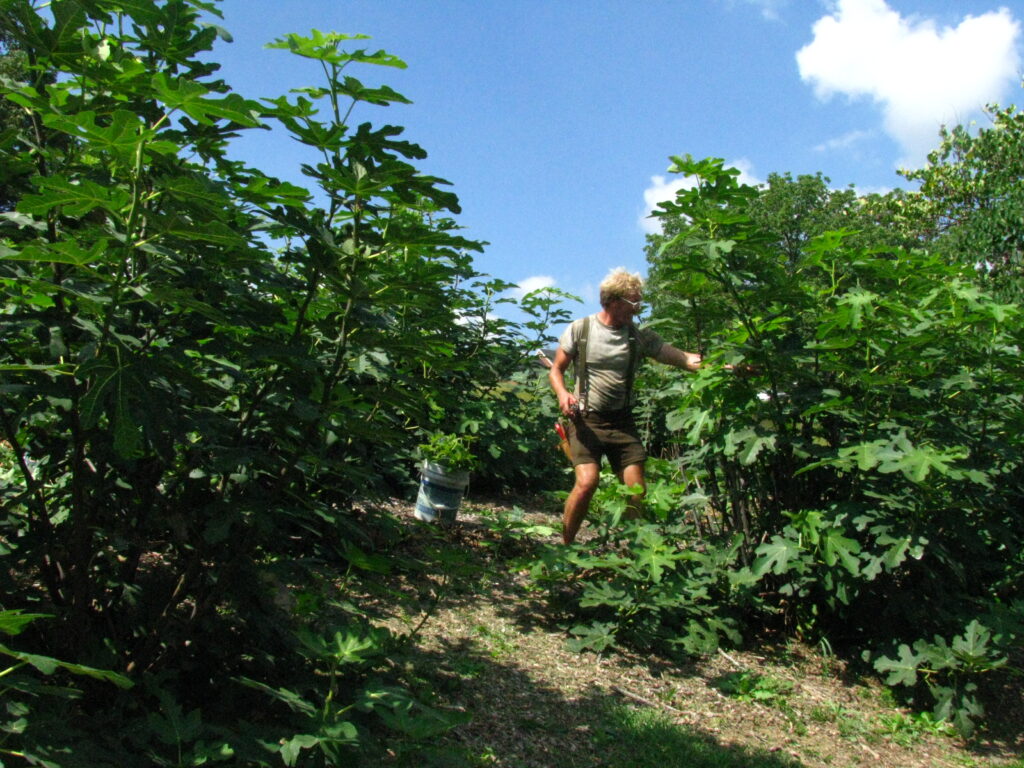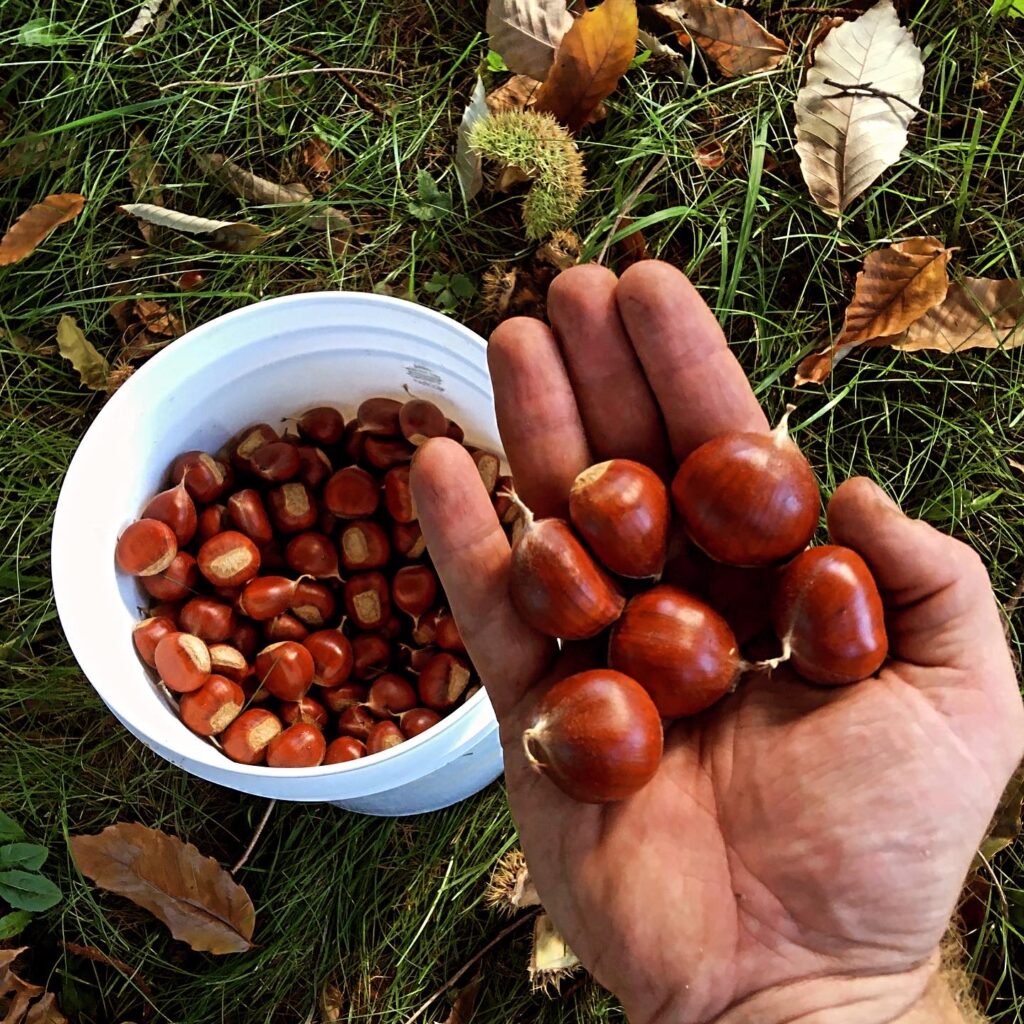Trees are always the answer. At least, that’s the impression you might get from mainstream reports on climate change. Apparently, trees will do just about anything. They could sequester all the carbon since the Industrial Revolution (so we can pump out more), clean polluted water and air, even replace annual crops and grow jobs and gender equity!
I sound dismissive, but I’m not knocking trees or those who sing their praises. I love these rooted beings dearly, which is why I propagate lots of them. My friend Cornelius Deppe and I co-caretake Silver Run Forest Farm, a nursery and folk school rooted in love and living soil. Those roots sprout out as agroforestry, watershed health, and restorative justice.
In our nursery, we grow thousands of beautiful and useful plants that cross-pollinate food sovereignty and ecological restoration. Basically, we cultivate and celebrate tree crops in the image of the forest. We do that to tend the life and health of places defined by the shape of land and flow of water rather than colonial borders and capitalist properties. That way, we might remediate the toxins that pollute our souls, society and soil, from erosion to empire.
These are bold claims for a small nursery in the Shenandoah Valley of Virginia, but we should be honest about our convictions. Even so, treating trees as technical solutions — for climate or political economy — is ecologically illogical. Practically speaking, it doesn’t work. Large-scale tree plantings often fail because of wrong location, wrong species, little monitoring, and top-down decisions made on behalf of people the projects are supposedly meant to serve. The colonial overtones are barely greenwashed: The vast majority of carbon emissions fume from the industrialized Global North, but the vast majority of tree plantations for carbon offsets break ground in the Global South. Who pays the price — and loses the land — when trees die?
Rather than cutting emissions or redistributing wealth, elite regimes dump huge sums of money to plant trillions of trees. An unprecedented flood of government and grant funding is currently flowing towards agroforestry. But long-term plantings, for tree crops or ecosystem restoration, require protected land tenure and dignified workers. White people own 98 percent of agricultural acres in the United States. This is the legacy of capitalist agriculture and colonial policies backed by state and vigilante violence. Funding for crops that require enduring land access mostly goes to those who own the land, not necessarily those who tend it.

The obvious truth is that trees always grow in context. Trees sprout in specific seasons and soils, planted by someone on land claimed by someone, guided by social systems and cultural customs. Counting saplings without collectively organizing is a dead-end.
I still want to plant lots of trees. But what should be planted, and how much? Those questions should depend on others: where, when, why, how and by who? New forestry research shows an “overwhelming scarcity of seedlings” in the United States. Available stock often isn’t sourced appropriately, meaning trees aren’t locally adapted to geography and season. A 2021 report concluded that U.S nurseries need to double tree seedlings to meet projected requirements for reforestation and carbon sequestration.
The numbers are complicated because many trees resprout — so not all sites need seedlings, not all land is suitable for trees (which is one reason why enormous tree plantings fail), and this research doesn’t directly address agroforestry and the negotiated need to share land between multiple uses. But what all this research clarifies is that massive monoculture tree planting doesn’t work and quantity and quality both matter.
A transformative way to plant trees and tree crops sees the forest along with the trees, as whole ecosystems instead of individuals. It addresses root causes from the local to the global, stems from clear goals coordinated with attentive care, and includes people affected by decisions in the process.
In the early pandemic swirl of 2020, we dug up plants from growing beds for our spring nursery season. Without proper planning, we had way more produce than purchases. We needed to move hundreds of healthy unsold plants before they woke from dormancy. Instead of potting them, we reached out to trusted friends and networks as a form of mutual aid: Please take our trees because we don’t have places to plant them! The response was quick, positive, and abundant. We transplanted everything to backyards, community farms, nurseries, nature preserves, land trusts and landback efforts up and down the eastern woodlands of Turtle Island, or what we now call the U.S.
We jokingly called this last-minute appeal our own version of a CSA, but instead of a community supported agriculture it’s a community solidarity agroforestry. We treat it like a wholesale contract with crowdsourced funds, affording us a fair amount of collaborative decision-making power to determine where our trees go. It’s also a way for us to imitate those trees, who give away a quarter to half of their sunlit energy through their roots to feed the underground economy of the soil. Photosynthesis might be an analogue of redistribution. Since 2020, we’ve given away nearly 8,000 trees, shrubs and cuttings (along with a percentage of our proceeds) through trusted networks and a radical underground of growers who know that restoration depends on reparation.
The scale of social change necessary to protect land and the humans that love it is planetary, and our scale is clearly not enough. But seeds start somewhere. So many gorgeous efforts resist and remediate the crises of global racial empire and the capitalist circuit that feeds it, from solidarity economies to cooperative structures to forest defense allied with abolition.
But the same global systems that devour fossil fuels and sacrifice zones also consume efforts for reform and revolution. Radical practices like agroecology and agroforestry are captured and coopted by capital, served back to us with the vibrant politics pruned out: Plant more trees, we’ll talk about labor and land ownership later. Trees have high growth potential, so venture capitalists are looking for short-term profit from long-term agroforestry, turning species that are in the commons into speculative commodities. If you can’t beat the movement, put a price on it.
I also like trees’ growth potential and don’t mind harvesting the economic fruit of our labor, but I want to keep agroforestry rooted in food sovereignty and tree planting rooted in biodiversity. Maybe we need to scale up tree nurseries rather than simply scale up tree plantings. Like woodlands and workers movements, we could do more through cooperatives and collectives. We could scale up agroforestry through people-power organizing, popular education and participatory action research, learning lessons from global farmer-to-farmer movements.

Our Forest Farm is part of a small collaborative experiment wondering what this could look like in our niche — and how we might meet tree needs to feed society and soil by photosynthesizing hoarded capital into joyful flourishing economies. A vertical cooperation of upstream growers and downstream planters and processors could weave a food web like mother trees and mycelium into an Eastern Woodland Nursery Alliance.
Even in this urgent time of the world, we can’t move faster than the “speed of trust” if we’re planting possible futures. Trust and trees grow at similar speeds (and share the same linguistic root), slow when necessary, fast once roots are down. We’re slowly convening listening sessions with land stewards and nursery growers to ask questions about scale and species and structures for nurseries rooted in local geography, agroecology and economic justice, so we can widely share responses and resources. This feels like the most important and satisfying aim of our nursery and any alliance of trees: propagating power to give away.
What would a theory of social change look like that grew from the power of plants? We grow plants because we love them and their vital place in the world. We also grow plants because we want to grow power that feeds us and the blessed land. Plants and power propagate from layers of roots and shoots of seeds, the established and emergent.
Our nursery sprouts a working theory of social change, both how a nursery can support social change but also how social change might move like a nursery. In this case, theory isn’t abstract concepts but a liberatory practice: What we imagine is possible and how we enact it. Paying attention to plants and people power, a nursery should:
- circulate and ground abundant fertility in place like a seedbank, not for permanent accumulation but for seasonal redistribution: the point is to keep the gift moving.
- preserve old ways and propagates new possibilities, playful experiments with serious implications for how we feed ourselves.
- strategize a biodiversity of tactics — a spectrum of plant allies, growing practices, production goals and distribution methods — instead of assume the same things work everywhere all the time.
- organize within its sphere of influence like a keystone species: connecting and effecting far beyond its size and location, instead of pretending it can change everything all at once.
- balance the vital labor of production and reproduction, the quantity of carrying capacity (how much we can sustain) and the quality of caring capacity (how well we can sustain it).
- know that nursing, to nourish and nurture life, is the foundation of every economy.
- grow like a tree, grounded in the conditions of the world as it is while also changing them to be more hospitable for its growth.
Another way to say all this: can we be multifunctional like trees? This is decidedly not multitasking, where we commit to many unrelated things at one time in a state of stress. We shouldn’t, and can’t, do or be everything. Instead, multifunctionality does many beautiful and useful things by being ourselves. Just by being themselves, trees shelter, shade, feed, hold, hydrate, respirate, filter, not by juggling endless tasks but as a benefit of their life cycle. How can the ways we organize and sustain ourselves imitate the multifunctionality of trees so that we give numerous benefits?
We have examples to look to and learn from, but we can’t replicate efforts from elsewhere. Context matters, for tree species and organizing specifics. In his excellent book “Land and Freedom,” Leandro Vergara-Camus compares the Landless Workers Movement of Brazil with the Zapatistas of Chiapas, as two distinct examples of Latin American land struggle and peasant alternatives to neoliberalism.
What connects them is the common ground of politics based on participation, economies based on subsistence and market necessities, land access grounded in autonomous tenure, and broad alliances linked for justice. Those four seed-scale propositions germinate into endless locally adapted possibilities, as the Zapatistas say, governed in accordance with our geography and our calendar. They trellis over borders between tree planting, food sovereignty economies and social movements.
Common ground and a nursery theory of social change also gives trees a way to be a right answer again. Not as technofixes but as living beings in partnership with people protecting land and water from destruction, shading soil and streets, calling back carbon from the commons of the atmosphere, celebrating old growth and resprouting cultures of care, and cultivating food and medicine for future generations so that everyone has enough. Small scale or large, it gives tree growers a world to plant at the edge of ecosystem and empire.